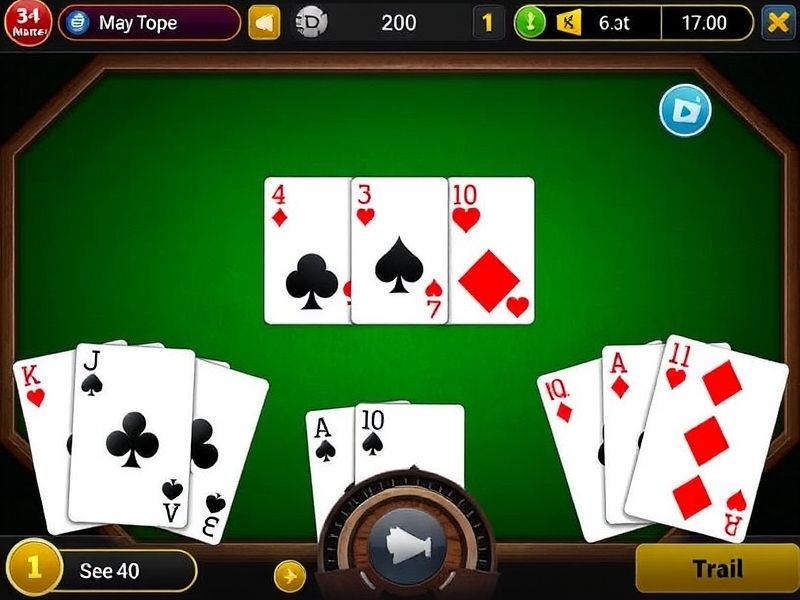
teen patti master tips and tricks - Hand Strength Guide
Background and Introduction
Hello everyone, today I'm excited to share some valuable tips and strategies for mastering hand combinations in Teen Patti (also known as 3 Patti). Many of you are likely familiar with the thrill and intrigue of this popular card game, but sometimes, even with a strong hand, victory can be elusive. Let’s dive into how you can optimize your play by understanding and leveraging your hand in Teen Patti, and how to adjust your betting strategy accordingly.
To begin, let’s briefly cover the basics of Teen Patti. This game, deeply rooted in Indian culture, is played with a standard 52-card deck. The objective is to outscore opponents by comparing three-card hands. Typically involving three or more players, each round involves strategic betting. Players must make informed decisions based on their cards and the actions of their opponents.
Hand Rankings and Fundamental Concepts
Mastering Teen Patti starts with understanding the hierarchy of hand rankings, which directly impacts the outcome:
- Straight Flush (Color Hand): The pinnacle of hands, featuring three consecutive cards of the same suit (e.g., A♠, K♠, Q♠).
- Run (Sequence): Three consecutive cards, not necessarily of the same suit (e.g., A, 2, 3).
- Pair: Two identical cards plus one different one (e.g., A, A, K).
- Three of a Kind (Same Suit): Three cards of the same suit (e.g., A♣, A♠, A♥).
- Three of a Kind (Same Value): Three cards of the same rank (e.g., A, A, A).
- High Card: A hand without any of the above combinations, judged solely on the highest card (e.g., K, Q, 10).
Understanding these rankings is crucial for evaluating hand strengths and adjusting strategies effectively.
Techniques for Mastering Hand Combinations
1. Understanding the Straight Flush (Color Hand)
Given its rarity and strength, a straight flush can be a game-changer:
Technique: Monitor Suits Always check for suit consistency among sequential cards. If two cards of a potential straight flush share a suit, keep an eye out for a third to complete this powerful hand.
Technique: Strategic Betting With a straight flush confirmed, consider increasing your bets cautiously, as your odds of winning are superior. However, stay alert to potential stronger hands from opponents.
2. Leveraging the Run (Sequence)
A run is robust and doesn’t require matching suits:
Technique: Sequential Awareness Monitor gaps in your sequences that could be filled to strengthen your run.
Technique: Advantage Utilization Confirming a run allows for more aggressive betting, but always be mindful of the opponent's potential stronger hands.

3. Maximizing the Potential of a Pair
Pairs are common but can be leveraged effectively:
Technique: Pair Evaluation Assess the strength of pairs based on card rank; higher pairs generally offer better protection against bluffing.
Technique: Betting Strategy Use pairs to drive your betting strategy, adjusting aggressiveness based on the pair's strength and perceived opponent hands.
Advanced Strategies for Top Combinations
1. Mastering Three of a Kind (Same Suit)
This hand's blend of rank and suit consistency makes it formidable.
Technique: Suit Consistency Checks Focus on achieving suit consistency within sets of three cards to elevate your hand’s strength.
Technique: Confident Betting With a confirmed three of a kind, proceed with confidence in your betting, navigating the fine line between boldness and caution.
2. Capitalizing on Three of a Kind (Same Rank)
Uniform ranks provide clarity and strength in decision-making.
Technique: Rank Strength Analysis Play up the inherent strength of uniform ranked cards, using them to guide your betting intensity.
Technique: Strategic Play Recognize when to push forward aggressively or pull back, based on the composition and confidence in your three of a kind.
Adaptability and Strategy Adjustments
Success in Teen Patti isn’t solely about the cards you hold but also about how you play them based on the game's dynamics.
1. Adapting Based on Opponent Actions
Reading the room and the opponent’s cues can provide critical insights.
Technique: Betting Frequency Analysis An opponent’s frequent betting can signal a strong hand, prompting a more conservative approach.
Technique: Bet Size Interpretation Large bets often indicate strong hands or bluffs; adjust your strategy accordingly to mitigate risks.
2. Strategy Refinement Based on Your Hand
Tailor your approach based on the strength and type of your hand.
Technique: Dynamic Betting Adjustments Adjust your bets upward with stronger hands and scale back with lesser combinations to balance risk and reward.
Technique: Hand Type Responsiveness React strategically based on whether you’re holding a flush, a run, or a pair by modulating your investment in each round.
Case Studies and Shared Expertise
Let’s look at practical examples to illustrate these strategies in action.
Case Study One: Straight Flush vs. Run
Imagine you hold A♠, K♠, Q♠. You’ve identified a straight flush, prompting a confident betting strategy. However, remain vigilant as opponents could also hold competitive hands like K♠, Q♠, J♠.
Case Study Two: Navigating Pairs and High Cards
With a hand like A, A, K, leverage the pair to guide your betting while staying mindful that opponents might have tied or higher pairs such

